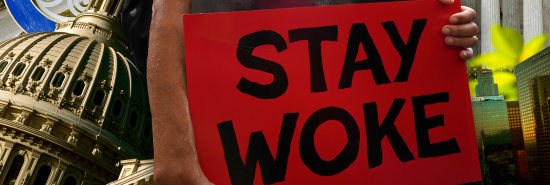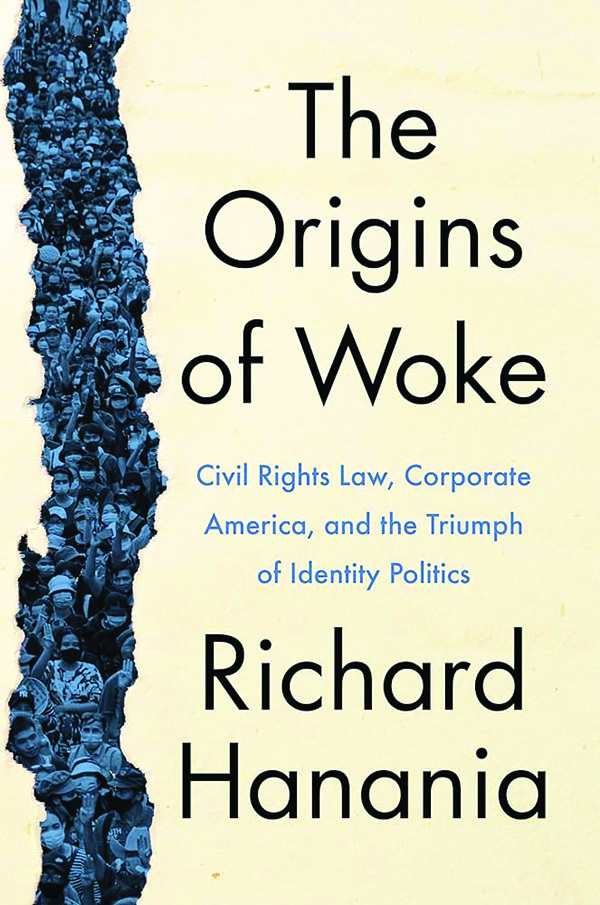
Reviewed: The Origins of Woke by Richard Hanania
Robert VerBruggen
Last month, the online trial of Richard Hanania provided an odd lesson in the politics of cancellation. The prominent commentator and academic had, the Huffington Post revealed, made disturbingly racist and sexist comments in the years around 2010, writing for far-right websites under a pseudonym. Hanania soon posted a well-written blog entry about how his views had evolved in a classical-liberal direction and survived the scandal. Then he bragged about how the affair had boosted his forthcoming book’s presales.

That book, The Origins of Woke — an argument for weakening civil rights law — indeed is being published as planned by Broadside, a conservative imprint of HarperCollins. How this happened without any outward signs of revolt from, well, woke staffers at the company is anyone’s guess.
BIDEN CONCEDES TO DONORS ‘A LOT OF PEOPLE’ ARE ‘FOCUSED ON MY AGE’
Ultimately, the tome is an interesting and mostly sober take on long-debated civil rights topics from one of the Right’s most frustrating figures, someone who can go from highly insightful commentary to dog whistle trolling at the drop of a hat, and still find time to defend the legacy media as “honest and good.”
Hanania’s project is to connect the civil rights debates of decades past to the modern phenomenon of wokeness. Indeed, from some of the more strident comments Hanania makes early in the book, one would think he’s arguing that civil rights laws are the sole root of all that is woke.
But the aggressive version of the argument is limited in numerous ways (some of which Hanania himself notes), and the book is best seen as a useful but partial explanation of recent phenomena. The public rise of wokeness happened abruptly, concentrated among college students and recent graduates. It’s tricky to explain an abrupt change with policies that have been in effect for decades — and the lefty kids who started it all were certainly not bureaucrats or employers trying to comply with civil rights laws. Younger generations’ heavy use of social media and academia’s promotion of jargon-laden left-wing ideologies (the history of which my Manhattan Institute colleague Christopher F. Rufo explains in his own exploration of wokeness, America’s Cultural Revolution) factor heavily in the overnight explosion of incessant “systemic racism” talk and pronouns in email signatures.
Civil rights law does connect with and explain, however, numerous other important aspects of wokeness, and fleshing out these connections is the key contribution of Hanania’s book. Certain tenets of wokeness are already, in some form, U.S. law. Modern debates about how to handle our country’s racial ills naturally mirror prior ones, with wokeness in large part comprising what once went by the names of “political correctness,” “identity politics,” “equality of outcome” (as opposed to equality of opportunity), and so on.
And civil rights law helps to explain why “diversity, equity, and inclusion” offices are so common everywhere from college campuses to huge for-profit corporations, with adult HR professionals pushing wokeness along with the purple-haired nonbinary 21-year-olds. As wokeness gripped colleges 10 or so years ago, many of us thought the students throwing temper tantrums upon encountering ideas they disagreed with were in for a wake-up call after graduation, but the phone never rang.
America’s civil rights statutes are largely the result of compromises Congress reached in the 1960s and 1970s. These compromises, however, were quickly shifted leftward by executive actions and court rulings. Many readers will already be familiar with this history, but Hanania does an able job of documenting it. Hanania’s account is impressively thorough, but a few policies in particular deserve mention.
One is the Civil Rights Act of 1964, which (among much else) broadly prohibited discrimination by private employers and within federally funded programs. It was primarily meant to end the racial caste system in the South, but its provisions expanded and warped over time through generous interpretive leaps by judges and bureaucrats.
Supreme Court decisions from the 1970s particularly exemplify this pattern. For example, nothing in the act’s text suggested that anti-white discrimination was exempt from the rules, but the court upheld both racial preferences in higher ed (Bakke) and a private sector hiring quota that had, in turn, been imposed to satisfy executive branch affirmative action requirements for government contractors (Weber).
The court also embraced the “disparate impact” doctrine (Griggs), which limits the hiring tools employers may use even if the tools were not selected with the intention of discriminating by race. If one racial group outperforms another on average, the burden then falls on the employer to demonstrate that the tool’s use is consistent with “business necessity,” meaning that the test genuinely predicts job performance. This despite the 1964 Civil Rights Act’s explicit language protecting professionally developed ability tests so long as they aren’t “designed, intended, or used” to discriminate.
In practice, racial gaps are ubiquitous, and pretty much any test or qualification will admit applicants from different racial groups at different rates. Thus, it’s easy to get past the first part of the test and require an accused employer to show business necessity. Hanania summarizes the process as “everything is illegal and the government will decide which violations it goes after.” One can certainly exaggerate the effects of disparate impact — in a recent survey of HR professionals by the Society for HR Management, more than half of employers reported using pre-hire tests of some kind — but it clearly makes the use of objective tests more expensive and risky.
Statutes regarding sex and gender followed a similar trajectory. The 1964 Civil Rights Act covered sex discrimination in private employment; this concept gradually expanded, first to obvious wrongs such as bosses’ demanding sexual favors from subordinates, and eventually to the amorphous concept of a “hostile work environment” that is “severe and pervasive,” with First Amendment-protected speech sometimes treated as evidence of such. Businesses naturally responded with zero tolerance policies toward, for example, edgy and inappropriate humor, homogenizing the workplace and restricting the options of those, male and female alike, who enjoy a more free-for-all environment in terms of speech among co-workers.
Meanwhile, Title IX, enacted in 1972, banned sex discrimination in federally funded programs, with the executive branch given considerable leeway to set some of the rules. Title IX came to mean that colleges had to boost female sports participation, actively prevent peer-to-peer harassment, and even adjudicate sexual assault allegations in disciplinary proceedings using a low burden of proof (a policy that lately has ping-ponged as the presidency changes parties).
The upshot of all this is that, regardless of whether they’re the one true root of wokeness, civil rights policies today are far broader than anything the public agreed to through their representatives in Congress. They go well beyond banning intentional discrimination and targeted harassment, and instead trample on free association and free speech in the name of creating more equal outcomes and taming workplaces and public institutions, while allowing intentional discrimination selectively, depending on the target.
Toward the book’s end, Hanania offers his path forward. Some skeptics of anti-discrimination law — from Richard Epstein and Dinesh D’Souza in the 1990s to Christopher Caldwell in 2020’s The Age of Entitlement — have toyed with the idea of outright repealing the core statutes, a fantasy that would require a consensus of the president and both houses of Congress, likely including a supermajority in the Senate to overcome a filibuster. Hanania proposes a more realistic and, for the vast majority of us who believe discrimination should indeed be illegal, more desirable solution: We could return to civil rights law’s original compromises the same way we departed from them, through politically easier moves such as executive actions and court rulings.
The current Supreme Court is clearly the most promising avenue. Its Students for Fair Admissions decision this year effectively ends affirmative action in higher education. Affirmative action in government contracting would be an obvious next step. The court could also take a broader view of the First Amendment vis-a-vis hostile work environment claims. The executive branch, meanwhile, could eliminate the executive order underpinning racial preferences in federal contracting, rework Title IX rules, and scale back disparate impact in the federal government and federally funded programs.
Ending disparate impact in private employment law is a different beast, though. The doctrine took hold with the incorrect Griggs ruling in 1971, but when the court later weakened the rule, Congress explicitly restored it in the Civil Rights Act of 1991. Hanania offers a parsing of the updated language in which it “specifies details regarding the burden of proof in a disparate impact claim” yet “does not explicitly mandate that standard in the first place,” which is too clever by at least half. It’s hard to get around statutory text if one lacks the political power to rewrite the law itself.
A different option Hanania proposes is for the Supreme Court to find disparate impact unconstitutional. The doctrine pressures liability-averse businesses to, in the late Antonin Scalia’s words, “evaluate the racial outcomes of their policies, and to make decisions based on … those racial outcomes,” in arguable violation of the equal protection clause. A fair counterargument, though, is that the doctrine merely requires businesses to show a good reason for policies that work to the disadvantage of some racial groups relative to others, and that this is, whatever its demerits as policy, at the very least not a violation of equal protection. It’s not clear whether the more cautious conservative justices would take so aggressive a stance to undo a standard that the court itself endorsed 50 years ago and Congress has made the law for 30.
All told, Hanania has drawn attention to long-standing issues in civil rights law and connected them to the endlessly discussed topic of modern wokeness. Readers can decide for themselves, of course, what to make of his own history and his evolution since.
CLICK HERE TO READ MORE FROM THE WASHINGTON EXAMINER
Robert VerBruggen is a fellow at the Manhattan Institute.
